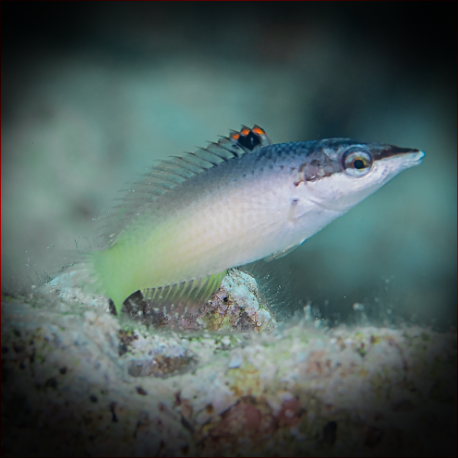More info
Datasheet
| Minimum Tank Size | 1000 litres / 264.17 US gallons |
| Maximum Size | 32.0cm / 12.60inches |
| Reef Compatible | Reef safe with caution |
| Temperament | Might be aggressive towards similar species |
| Temperature | 22.2°C / 71.96°F - 25.6°C / 78.08°F |
| Specific Gravity | 1.020-1.025 |
| Carbonate Hardness | 8-12 |
| pH | 8.1-8.4 |
General Description: The Green Birdmouth Wrasse, scientifically known as Gomphosus caeruleus, is a member of the Labridae family. These fish are characterized by their beak-formed jaw, which they utilize to hunt for prey within rock and coral formations. Their diet mainly consists of crabs, shrimps, crayfish, mussels, small fish, and starfish. If the prey is too large, they will crush it against rocks to consume it. They are often found sleeping amongst rocks.
Aquarium Suitability: Suitable with care, the Green Birdmouth Wrasse is known to be aggressive towards similar species if not provided with sufficient space. They can coexist in pairs if introduced simultaneously and require good hiding spots within the tank.
Demands: This species is hermaphroditic, able to change gender from female to male. They need a varied diet that includes larger crustaceans, other invertebrates, and small crustaceans like krill and mysis. They must also have plenty of space for swimming, as they enjoy swimming and require ample room in the aquarium.
Care and Hardiness: Considered hardy, these wrasses are quite adaptable to different tank conditions. They can be aggressive if housed with very similar fish species and will benefit from a spacious environment.
Reef Suitability: Reef safe with caution, the Green Birdmouth Wrasse can be kept in a reef aquarium. However, they may pose a threat to smaller fish, crustaceans, and may nibble at clams.
Aquarium Setup: When setting up the tank for the Green Birdmouth Wrasse, ensure there are plenty of hiding places amidst live rocks. The tank should also allow for ample swimming space to accommodate their active swimming behavior. Water conditions should be maintained at a temperature between 22.2-25.6°C, a pH of 8.1-8.4, a specific gravity of 1.020-1.025, and a KH level of 8-12.
Behaviour: These wrasses can display aggressive tendencies, especially towards similar species. They are known to jump out of open aquariums, so a secure lid is recommended to prevent escapes.
Feeding and Diet: The Green Birdmouth Wrasse must be fed a varied diet consisting of larger crustaceans such as shrimp and crabs, other invertebrates, and small crustaceans like krill and artemia. Providing a diverse menu will help ensure their nutritional needs are met.
Habitat and Distribution: Found in the Indian Ocean, these wrasses are native to the waters stretching from East Africa (South to Natal, South Africa) to the Andaman Sea. They are often observed in reef environments, where they assist in controlling populations of unwanted invertebrates such as flatworms and pyramid snails by preying on them.

